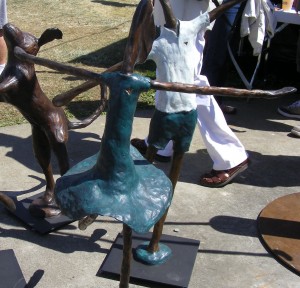
Sometimes more is more, but often LESS is more.
That’s one of the reasons Twitter is so powerful and popular, and it’s also the reason why this post will include only Ten Twitter vocabulary items.
You can find dozens of twitter words and definitions in the wiki Twictionary, and in my earlier article Twitter Basics — Workshop “Cheat Sheet” where I defined 12 common twitter jargon words. This post, however, is designed to provide a deeper understanding of the terms you really need to “work” Twitter and make Twitter “work” for you.
Here’s your “Annotated” Word Introduction to Twitter
1 – TWEET – The 140-character post on Twitter. It is also called a Microblog, i.e. a condensed and concise statement that often links to blog articles. Live Tweeting is practiced at events — both face-to-face and online — where participants contribute an ongoing report of the proceedings. You can even find Live Tweets at events like actual hospital surgeries.
2 – FOLLOW – You follow people to read their tweets — to keep up with the latest news, trends, entertainment, and happenings of friends, celebrities, and knowledgeable people. Unlike Facebook where you must be accepted — and where there is a limit to how many friends you can have — you can follow anyone you want to. See previous posts for tips on Whom to Follow.
However, you can block someone from seeing your tweets OR, of course, someone can block you. The difference is that you don’t request permission to follow someone. You just do it. And if you are not a scammer, a robot, or in some other way intrusive, you probably won’t be blocked.
3 – TWITTERSTREAM [or Stream of Tweets] – It you access Twitter via the actual site Twitter.com, then you will see a “stream” of posts from the people you follow. These would be the most recent statements they posted in reverse chronological order, i.e., the newest posts are up at the top. If you select PROFILE from the top menu, you will see your Twitterstream, i.e., what you have posted in reverse chronological order.
This stream of posts is what someone else would see if they searched Twitter for your handle [your Twitter name]. For example, click on twitter.com/sharisax and you will see my twitterstream. If you liked what you saw, then you would follow me by clicking the FOLLOW button below my photo [your photo is also called your avatar].
As stated in the previous post Tips to become a Twitter Pro BEFORE your first post, I suggested that you plan your Twitter strategy before you write your first post: know Why you are on Twitter and What Twitter image you hope to accomplish. Your Twitterstream will be How you accomplish that image, i.e., your “personal brand.”
4 – FOLLOWERS [those who read your Tweets] – Influence and/or popularity seems to be measured by how many followers one has. You can find out the 200 most followed Tweeple [a person who Tweets] on a site like Twitaholic.com: as of this writing, celebrity Kevin Smith has 1.7+million followers.
“So What?” That is a common question asked by journalists when any extraordinary statistic is thrown at them. If numbers are your sole objective, there are automatic, robotic means of accruing a slew of followers. My suggestion, however, is that you grow your follower list organically. That means the list of people who follow you develops naturally, i.e., people either follow you because they like reading what you Tweet OR, in many cases, they follow you back automatically when you follow them. [Hint: that is one typical way to gather followers.]
5 – DM or Direct Message – Once you follow someone and he or she follows you back, you may DM the person, e.g. D sharisax [by using a Capital “D” and a space and the person’s twitter handle]. This is NOT a Tweet to everyone, but a private text message to one person. Personally, I do not text very often on my cell phone, but I do DM lots of my Twitter friends — and these relationships have grown faster and deeper than others because of the ease of communication. Engagement and building relationships is what the Social Web is all about. More than a few technology/Internet pundits have predicted that Twitter will replace much, if not most, of email in the future. [Who likes to read all the previous messages and other extraneous verbiage on emails.]
6 – RT or ReTweet – This is the action of re-posting someone else’s Tweet with attribution, e.g. RT @sharisax Sometimes more is more, and sometimes less is more. [Use the “RT” and then a space and then the “@” sign in front of the person’s handle — all this in front of what they tweeted.] When someone RT’s what you have posted, you feel recognized and appreciated. Many people make it a practice of Thanking those who RT them. Of course, once you are so popular that 100’s of people RT you, then you might not have time for much else other than thanking people if you stick to this practice.
All that being said, the practice of RT-ing is one of the reasons that you don’t need to worry about missing much of the good stuff on Twitter. If it truly is “good stuff,” then it is surely likely to be RT’d.
7 – SEARCH.TWITTER.COM – Searching Twitter [now integrated on the Twitter interface] offers “real-time” results, i.e., What people are Tweeting at the moment you input your keywords . . . unless your the terms are obscure, i.e., no one but you is interested. This is one of the best methods for finding people to follow — by inputting topics of interest and finding like-minded people. Read their streams and then follow them if you like what they have to say. You might want to reply or retweet, so they will have an additional incentive to follow you back. And you might even find someone who becomes one of your face-to-face friends. [I have 🙂 ]
You can narrow your search through operators like these two examples [complete list]:
news 🙁 —– search contains word “news” and with a negative attitude
“happy hour” near:”san francisco” —– search contains exact phrase “happy hour” and was sent near “san francisco”
8 – Tweetdeck.com – This is the desktop application I use to more fully engage with my followers and topics I follow. I will post a complete article explaining how to download and use this valuable tool.
9 – Tweetchat.com – Twitter can be used for chatting real-time. The way it works is that everyone in the chat is using a certain keyword (called a hashtag) in all their tweets. The applications are then grabbing all the tweets with that hashtag (defined below) from Twitter and displaying them for the people who are part of the chat. Be careful though because your tweets are also going out to all the people who are following you.
10- My own previous “worksheet” for new Tweeters with these terms and more as well as a new site 109 Slang Terms for Tweeters
PS I just remembered URL shorteners like bit.ly. Most people use a site like bit.ly to reduce the number of characters in the URL. This site also has functionality to track your shortened URLs to report on how many times people click on them.
PPS How could I forget to define Hashtags? Tweeters use the number symbol # in front of a word [e.g., #journ65] to identify a topic that makes it easy for people to (a) search for and (b) contribute to the discussion — whether the discussion is happening real time or just “over” time. One example of a real time hashtag discussion would be live tweeting during a webinar. The hashtag could be as simple as the name of the moderator; George Kao happens to be one of my mentors, and when he holds one of his Q&A sessions, I would tweet using the @georgekao hashtag, so people can follow the discussion and add to it.
Which terms would you add to this list, and what would you say about them?
